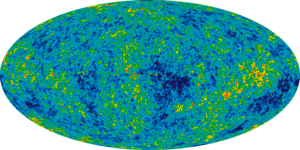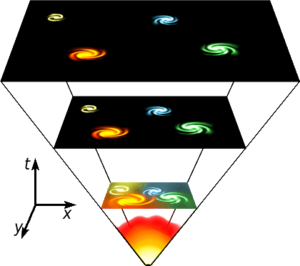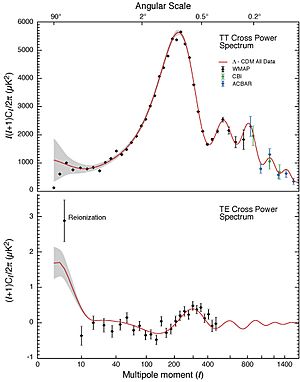History of the Big Bang theory facts for kids
| Physical cosmology | ||||||||||||||
 |
||||||||||||||
| Universe · Big Bang Age of the universe Timeline of the Big Bang Ultimate fate of the universe
|
||||||||||||||
The Big Bang theory is our best idea about how the universe started. It says the universe began from a tiny, super-hot, super-dense point and has been expanding ever since. Scientists developed this idea through many observations and deep thinking. Father Georges Lemaître first put the theory into a clear form in 1927. Later, Hubble's Law, which showed the universe is expanding, strongly supported this idea.
Contents
Early Ideas About the Universe
For a long time, people wondered if the universe had a beginning or if it had always been here. In the Middle Ages, thinkers like Robert Grosseteste in 1225 wrote about the universe starting with an explosion of light. He thought matter then formed stars and planets. This was one of the first times someone tried to explain the heavens and Earth using the same rules.
Later, in 1610, Johannes Kepler used the dark night sky to suggest the universe might not be endless. In 1791, Erasmus Darwin wrote a poem about a universe that expands and shrinks in cycles. Edgar Allan Poe also wrote about a similar idea in 1848. He imagined the universe starting from a single "Primordial Particle" that exploded. Then, gravity would pull everything back together, only for it to explode again. While not scientific, his ideas shared some thoughts with modern cosmology.
Discovering an Expanding Universe
In the 1910s, scientists like Vesto Melvin Slipher and Carl Wilhelm Wirtz noticed something strange. They saw that most "spiral nebulae" (which we now know are spiral galaxies) were moving away from Earth. They used a method called spectroscopy to see this "redshift." Redshift means light from distant objects stretches out, making it look redder, which tells us they are moving away. At the time, they didn't realize these nebulae were other galaxies far beyond our own Milky Way.
Around the same time, Albert Einstein developed his theory of general relativity. His equations showed that the universe couldn't stay still; it had to be either expanding or shrinking. Einstein himself tried to add a "cosmological constant" to his equations to make the universe static. But Alexander Friedmann in 1922 found solutions that showed an expanding universe was possible without this constant.
In 1927, the Belgian physicist Georges Lemaître took these ideas further. He suggested an expanding universe could explain the redshifts Slipher and Wirtz observed. He also calculated what we now call Hubble's law.
In 1929, Edwin Hubble provided strong proof for Lemaître's theory. Hubble and Milton Humason observed that galaxies are moving away from us in every direction. The farther a galaxy is, the faster it moves away. This is Hubble's law. If everything is moving away from everything else, it means everything must have been closer together in the past. This led to the idea that all matter started from a single, tiny point that exploded outwards. This huge explosion, still expanding billions of years later, is what we call the Big Bang.
In 1931, Lemaître called this beginning the "hypothesis of the primeval atom." He thought cosmic rays might be leftovers from this event. He later learned about the discovery of cosmic microwave background radiation, which is truly the leftover glow from the early, hot universe.
Big Bang vs. Steady State
Hubble's Law suggested the universe was expanding. This led to two main ideas about the universe:
- The Big Bang theory: Supported by Lemaître and George Gamow, this idea said the universe started from a hot, dense state and has been expanding and changing ever since.
- The Steady State theory: Proposed by Fred Hoyle, this idea said that new matter was constantly being created as galaxies moved apart. In this model, the universe always looked roughly the same, no matter when or where you looked.
It was actually Fred Hoyle who first used the term "Big Bang" in a radio broadcast in 1949. He meant it to highlight the difference between the two theories, though some thought he used it to make fun of Lemaître's idea. Hoyle himself said it was just a striking image.
As more evidence came in, the Big Bang model gained more support.
New Discoveries in the Late 1900s
From the 1950s to the 1960s, scientists were still debating. The Big Bang theory could explain why the universe has the amounts of hydrogen and helium we see. The Steady State theory couldn't explain this as well.
Then, observations started to strongly favor the Big Bang. Scientists saw that objects like quasars and radio galaxies were much more common far away (meaning in the distant past) than they are closer to us. This showed the universe was changing over time, which fit the Big Bang idea, not the Steady State.
The biggest discovery came in 1964: the cosmic microwave background (CMB) radiation. This faint glow of radiation coming from all directions in space is like an echo of the Big Bang. Its discovery was a huge blow to the Steady State theory. After this, the Big Bang became the leading theory for how the universe began and grew.
Before the late 1960s, some scientists wondered if the universe might have shrunk before expanding again, like an oscillating universe. But Stephen Hawking and others showed that the Big Bang's starting point, called a singularity, was a key part of Einstein's gravity theory. This led most scientists to agree that the universe has a finite age.
Even with the Big Bang widely accepted, some puzzles remained in the 1970s and 1980s. For example, scientists couldn't find tiny differences (anisotropies) in the CMB, and some observations seemed to hint at problems. So, the theory wasn't fully confirmed yet.
The Big Bang Today
Since the 1990s, we've made huge progress in understanding the Big Bang. This is thanks to amazing new telescopes and satellite data from missions like COBE, the Hubble Space Telescope, and WMAP.
In 1990, the COBE satellite showed that the CMB's light perfectly matched what's called a "black-body" spectrum at 2.725 Kelvin. This was incredibly precise and proved that the universe was once very hot and dense. In 1992, COBE also found the tiny differences in the CMB that scientists expected. These small variations are like seeds that grew into the galaxies and structures we see today. After this, other ideas about the universe without a Big Bang became very rare.
In 1998, observations of distant supernovae (exploding stars) showed something surprising: the universe's expansion is actually speeding up! This was also supported by other observations. In 1999-2000, balloon experiments called Boomerang and Maxima showed that the universe's overall shape is nearly flat.
From 2001 to 2010, NASA's WMAP spacecraft took very detailed pictures of the CMB. These images helped scientists figure out that the universe is about 13.7 billion years old. They also strongly supported the Lambda-CDM model and the inflationary theory, which are key parts of the Big Bang model. No other theory can explain so many different things we observe, from the amounts of elements in the early universe to the structure of the CMB.
In 2013 and 2015, ESA's Planck spacecraft gave us even more detailed images of the CMB. These images continued to show that the Lambda-CDM model is very accurate.
Today, much of the work in cosmology focuses on understanding how galaxies formed within the Big Bang model. Scientists also want to know what happened in the very first moments after the Big Bang. They are constantly making more precise measurements to learn about mysterious things like dark energy and dark matter.
See also
 In Spanish: Historia de la teoría del Big Bang para niños
In Spanish: Historia de la teoría del Big Bang para niños
- Theory of everything
- Timeline of cosmological theories



